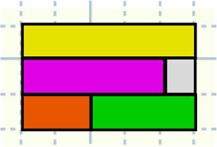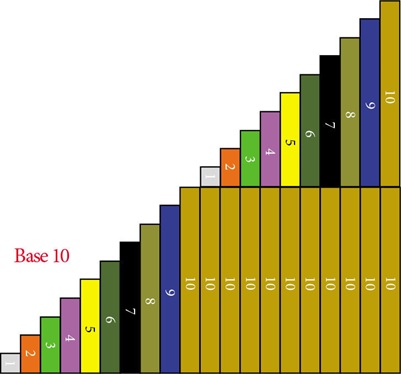“The teacher pretended that algebra was a perfectly natural affair, to be taken for granted, whereas I didn’t even know what numbers were. Mathematics classes became sheer terror and torture to me. I was so intimidated by my incomprehension that I did not dare to ask any questions.”
—Carl Gustav Jung—
REASON 1: The Most Important Learning State Is Absent
Young children are natural learners. They are genetically programmed to learn. But if a child is feeling stressed, intimidated or if something has upset him prior to arriving at his schoolwork, he will not be in any state to learn anything. Stress causes the equivalent of an electrical storm in the brain, cutting off access to the areas that control our higher thinking skills. Math seems to induce more stress than any other subject. What you must do is create an environment where your child feels secure and where learning math can be challenging—but always fun. Whether you like it or not, you are your child’s first and most important teacher.
REASON 2: Too Formal Too Soon
One of the things that always frustrated me was to observe children counting on their fingers when asked to perform simple addition. It revealed so much about their lack of understanding of numbers. Like Jung, these children never really understood what numbers are. The root cause is almost always to be found in the first few years of schooling when children are exposed to formal math activities (sums) before they have grasped the underlying concepts.
Numbers pose a real problem for young children. The reason being that “number” is an abstract concept. What does this mean? Take any number you like, for example five. If I were to ask you to go and fetch me five you would naturally respond, “Five what?” Numbers only exist in relation to something concrete … five gold rings, three French hens, etc. Children are unable to perform simple sums (such as addition problems to ten) because they cannot perceive five as an entity in itself—only as a series of individual objects. As one exasperated adult pointed out, their teachers were unable to help because … “they didn’t understand why we don’t understand.”
REASON 3: We Ignore This Learning Style at Our Peril
There is one learning style that is essential if young children are to learn effectively. Young children are hands-on learners. This tactile approach to life in general is their way of discovering and processing information about the world around them.

Free Play – Talk about children’s artistic creations.
Offer plenty of encouragement and praise children’s work.
Value it.

Incidental Learning e.g. Number Bonds

The rods allow learners to investigate mathematics for themselves at every level of development.
Play is how children utilize this learning style.
Play is one of the most powerful vehicles for facilitating learning. When you play with your child you are demonstrating how much you value them. This helps build emotional intelligence and many studies now reveal that children with high emotional intelligence will outperform children with higher IQ. The tendency for state education to focus on a more formal, left-brain orientated approach to learning can have disastrous implications for a significant percentage of children, particularly boys, who tend to be predominantly tactile learners.
If you harness the power of play, you will effectively lead children to an understanding of math concepts. Adopting a more child-centered approach will eliminate the struggle with math so that they will not disengage from learning.
REASON 4: The Most Complete Math Model in the World Is Underused
George Cuisenaire was perplexed. Why did children find it so difficult to learn math? His solution to the problem was to invent the most complete math model ever devised. It consisted of a set of colored rods of wood ranging in size from one centimeter to ten centimeters. The rods allow learners to investigate mathematics for themselves at every level of development. He realized that the rods provided teachers with a means for making the lesson a personal investigation of mathematics for every child. His subsequent work where the rods were used and where teaching was learner-centered convinced him and others that all children have a latent ability which can yield truly remarkable results. Their genius is in their simplicity. Like a piano, once the basics have been mastered it is possible to create an infinite variety of math shapes, patterns and equations.
The nature of Cuisenaire rods allows for open-ended tasks and problem solving that enables your child to develop at his/her optimum learning level. One of the hidden benefits of using Cuisenaire rods is the enriched sensory stimulation your child receives through plenty of handling and touching. Research shows infants who receive enriched sensory stimulation become more mentally alert and physically stronger. Consider it brain-friendly learning for your child.
One of the brain’s abilities is the capacity to recognize color. Color creates an emotional response. Using Cuisenaire rods, children can be introduced to basic math concepts before having to cope with numbers.
Visual learners will respond to the color of pattern and relationships revealed by Cuisenaire rods.
REASON 5: The Dominance of Negative Vocabulary in the Math Lesson
“For as he thinketh in his heart, so is he” (Proverbs 23:7).
Math lessons can be dominated by negativity. If a student is continually told they’re doing it wrong, the child says to himself, “I’m useless at this!” Words affect the way we think and act. Children are particularly vulnerable to the shaping power of words.
They influence our emotional state, the most important state for learning. Many children’s lives have been blighted by a thoughtless remark they have secretly carried with them all their lives. Everyone who has authority over children should consider their words very carefully. We need to be very careful what seeds we sow in our children’s minds.
But math is all about right or wrong, right? Wrong! As French philosopher Bachelard once said, “There are no first truths, only errors.” It has been said Thomas Edison engaged in over one thousand unsuccessful experiments before finally inventing the electric light bulb. It is this spirit of enquiry and persistence that is the key to achieving anything worthwhile. Trial and error is also important in math. This is the most effective kind of learning, and children will delight in the process.
Feed your child a diet of positive talk about math. There are words we can use to activate our child’s abilities. If we model positive talk, our children will unconsciously copy it. Your child will reap the emotional, physical and spiritual development as they learn math in a positive, enriching environment.
Editor’s Note: Philip Rowlands teaches Hands-On Math Help with Cuisenaire Rods through Schoolhouseteachers . com
Copyright 2017, The Old Schoolhouse®. Used with permission. All rights reserved by the Author. Originally appeared in the Spring 2017 issue of The Old Schoolhouse® Magazine, the trade publication for homeschool moms.